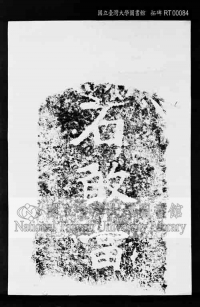TELDAP Collections
| Shi Gan Dang |
|
Main title: Shi Gan Dang
Date: Unknown
Description: The following is a paragraph in He Pei-fu’s The Stories of Steles in Taiwan. “The real origin of Shi Gan Dang is untraceable but using stone materials for the engraving of ‘Shi Gan Dang’ can be traced back to Tang Dynasty. Shi Gan Dang gradually became common after the Song Dynasty and even spread to the Ryukyu Islands of Japan. The ancients long realized that the characters of stone materials—hard, solid, and bearable—so they apotheosized Shi Gan Dang. Shi Gan Dang are often set in the four corners of a village to secure the safety of its residents. They can be seen on beaches, at ports, ponds, T-shape intersections, and alleyways to guard surrounding areas. They can also be seen at the entrance and exit of houses, corners, backyards, and fences in order to put up a last defense to ward off evil.“ (Note 1: This rubbing of the stele is obtained from the Shih-Pai district of Taipei City. The original stele cannot be found today.)
Collection: Rubbings of Taiwan Cultural
Shi Gan Dang, also named Tai Shan Shi Gan Dang, are large stone tablets located in alleyways. Shi Gan Dang are found on walls at intersections, some which bear inscriptions to ward off evil. Characters like “Shi Gan Dang” or “Tai Shan Shi Gan Dang” are carved with lion and tiger head reliefs at the head of the stone inscription. National Taiwan University Library, National Taiwan University
|













